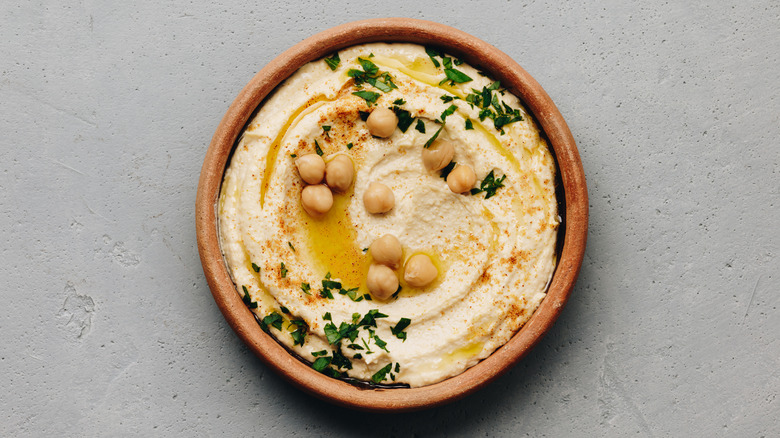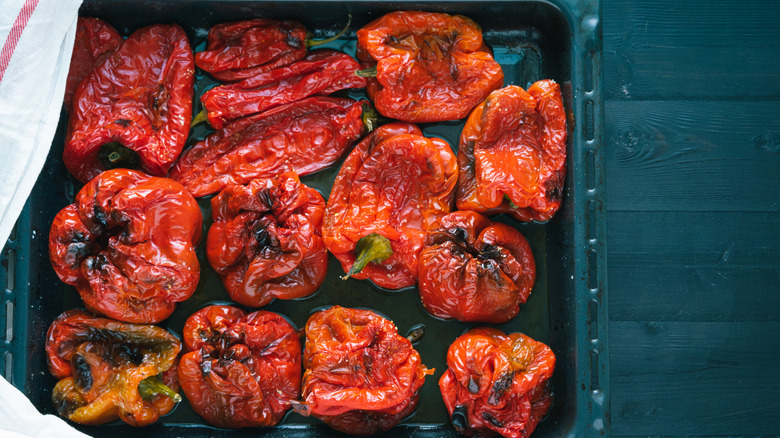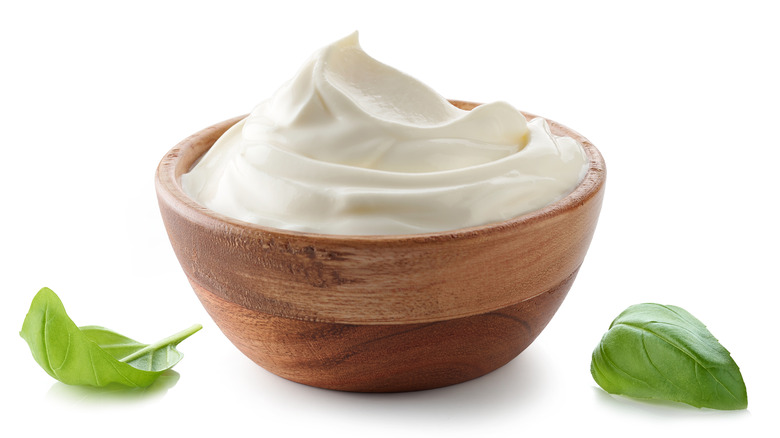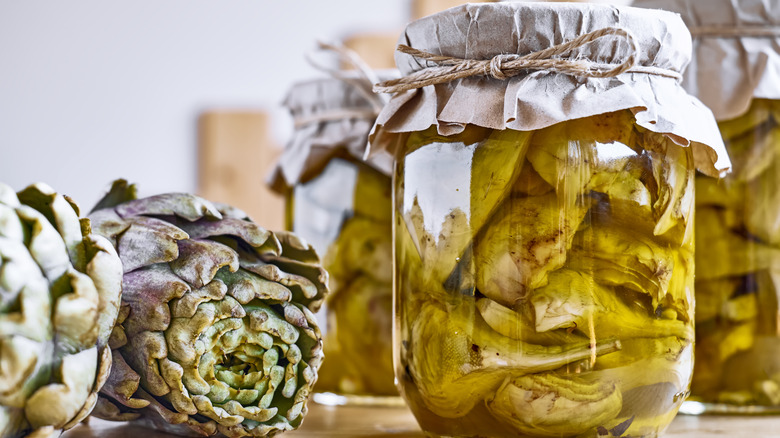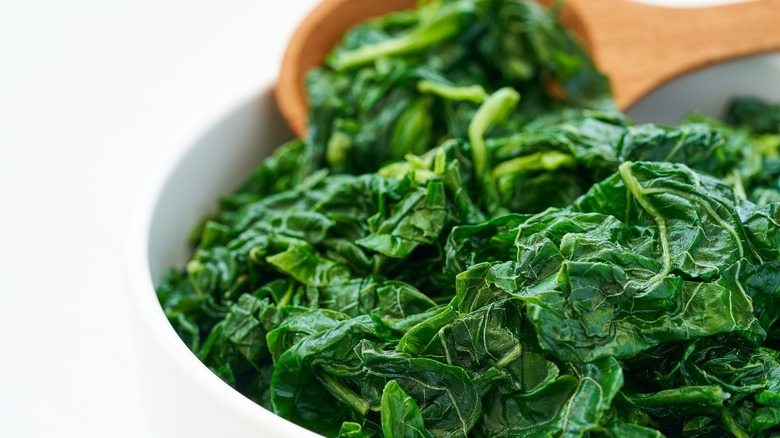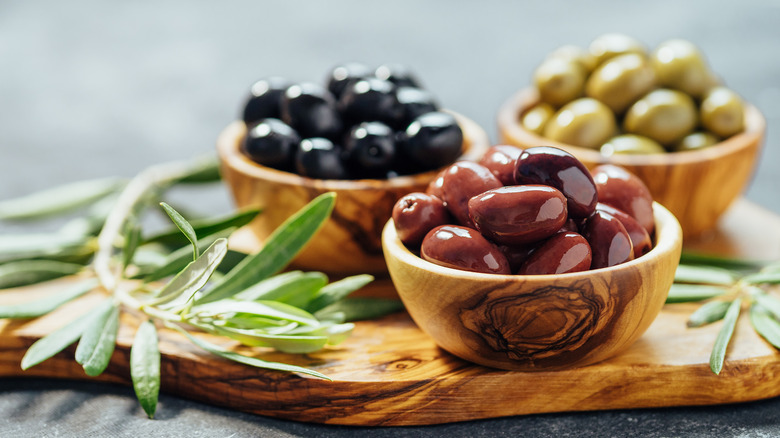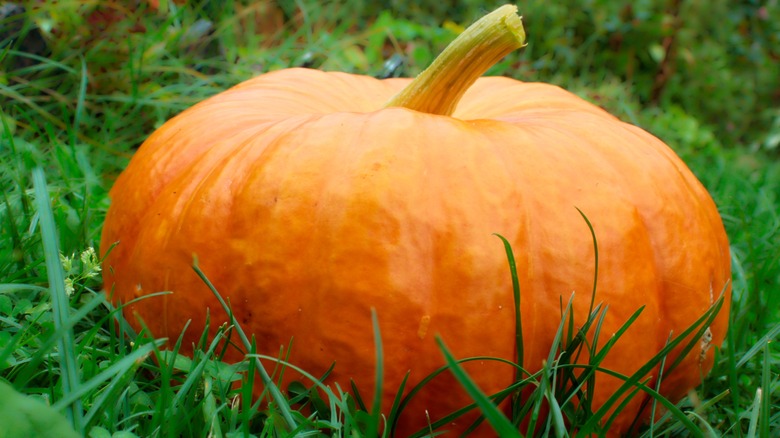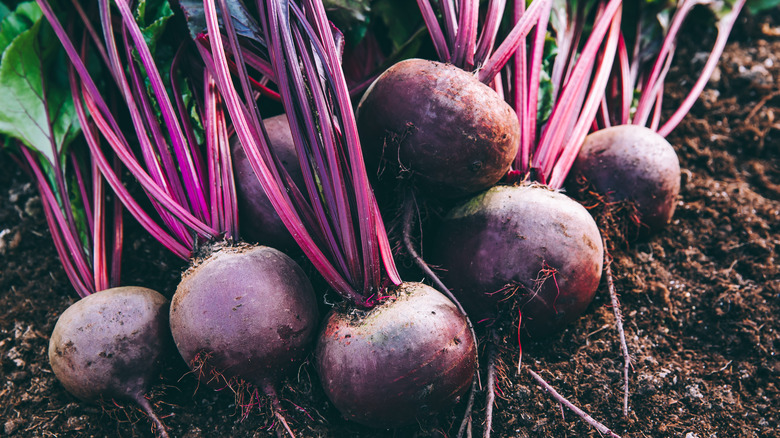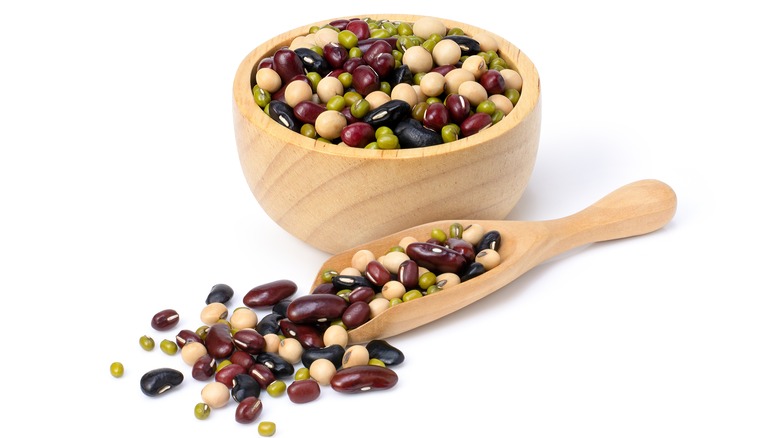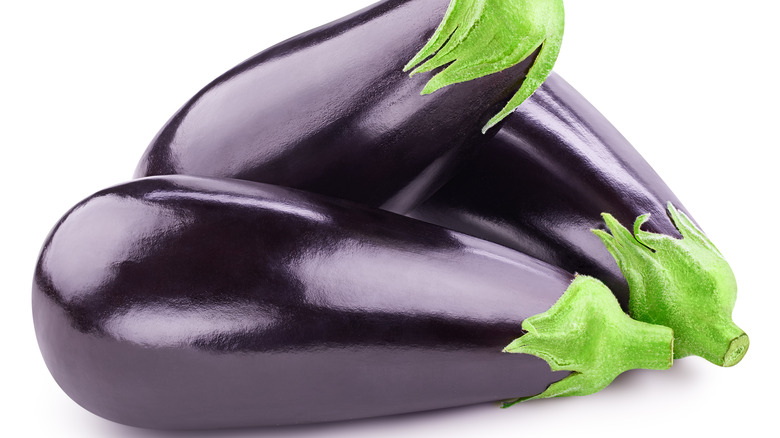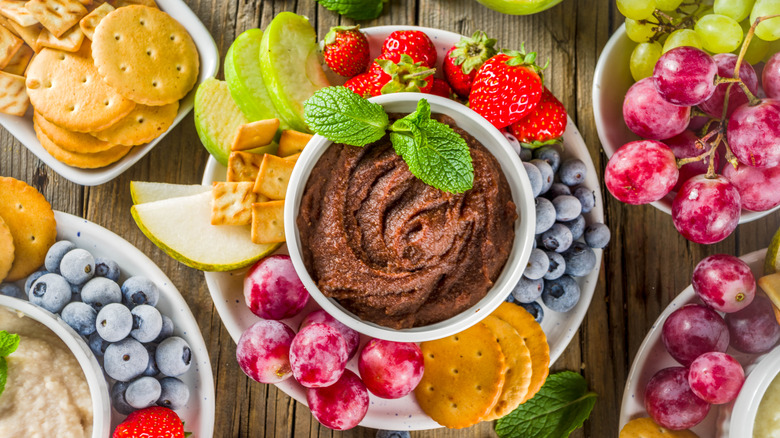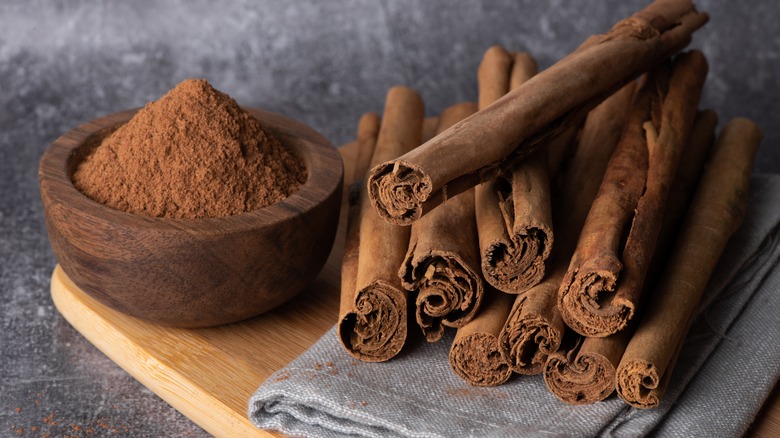11 Additions That Will Take Your Hummus Up A Notch
Hummus has been a staple in Middle Eastern and Mediterranean diets for centuries, but it has only been in the past two decades or so that this chickpea-based dish has become popular in the United States. While it was once relegated to the ethnic or health food sections of a store, it's gone mainstream now. Walk through the prepared foods section of any grocery store and you will find countless brands and varieties of hummus. This versatile spread works well on sandwiches or as a dip for crackers and vegetables.
Even though you can pick up a container of hummus at the store, it's so easy to prepare that there's no reason not to make your own. Making your own hummus allows you to control the ingredients, meaning you can alter the flavor and the nutritional profile to suit your preferences. All you have to do is toss canned or cooked chickpeas into a food processor with tahini, olive oil, and lemon juice. Start with this recipe for creamy homemade hummus and adjust the proportions to taste. Once you have mastered the basics, you can try tossing in some extra ingredients to take your hummus up a notch.
1. Roasted red peppers
Roasted red pepper hummus is one of the most common flavors you'll find in the stores, but you can easily make it at home. Just make hummus as you normally would but add one to two roasted red peppers (or more — you be the judge) while pureeing. Roasted red bell peppers from a jar work fine, or you can make your own roasted peppers.
Adding roasted red peppers not only enhances the flavor but adds a nutritional punch to your hummus. Bell peppers are packed with vitamins and minerals (per Healthline). Just one bell pepper contains 169% of your reference daily intake (RDI) of vitamin C! Bell peppers are also a great source of vitamins B6, A, E, K1, and folate as well as the mineral potassium. They also contain a variety of antioxidants that may be beneficial in preventing heart disease and cancer as well as improving eye health.
You can use roasted red pepper hummus just like you would use classic hummus, but you can also incorporate it into other recipes. For example, roasted red pepper adds moisture and flavor to these hummus turkey burgers. Mixing the hummus directly with the turkey, as opposed to spreading it on the bun, fully incorporates the flavor into the burger patty.
2. Yogurt
Yogurt might seem like a funny ingredient to add to hummus, but it works! Yogurt is a staple of many Middle Eastern and Mediterranean dishes, and can also serve as the base for many dips, so it actually makes sense to add yogurt to hummus. Simply replace the tahini and olive oil in your hummus with Greek yogurt and prepare just as you normally would.
Be sure to use plain Greek yogurt, not regular or flavored yogurt of any sort. Greek yogurt's thick consistency will work well with hummus, but regular yogurt is too thin and will result in hummus that is runny. As for flavored yogurt — well, the fruit flavors and added sugar do not complement the savory taste of hummus.
For a different take, you can pair yogurt with hummus as opposed to blending it in. This recipe for lemon hummus with lebneh uses strained yogurt to make a thick Lebanese cheese known as lebneh. To serve, make a well in the hummus, then place the lebneh in the well for a beautiful presentation. Served with cut pita bread, crackers, or assorted vegetables, this recipe is perfect for entertaining.
It's worth adding yogurt to your hummus because it provides so many nutritional benefits. According to Medical News Today, yogurt is a good source of calcium, vitamin B12, iodine, and protein. Yogurt also provides probiotics through the bacteria that ferment milk into yogurt. These beneficial bacteria can help people to achieve a healthy balance of bacteria in their gut.
3. Artichokes
When you think of artichokes and dip, you probably think of cheesy, gooey spinach and artichoke dip, not artichoke hummus. Recipes for spinach and artichoke dip vary, but most are based on either mayonnaise or cream cheese, which contain a lot of saturated fat but not a lot of nutrition. Artichoke hummus is a healthy but tasty alternative to these dips.
To make artichoke hummus, add canned or frozen artichoke hearts to your hummus before you purée it — make sure the hearts are fully thawed if you're using a frozen variety. Drain the artichokes before adding them to avoid runny hummus. Canned artichokes often come in brine, so you may want to rinse them first to remove some of the salt. If you are serving artichoke hummus at a party, save a few artichoke hearts and place them on top of the dip. Serve with brightly colored vegetables like grape tomatoes, baby carrots, and broccoli florets for a pleasing visual presentation.
Artichokes are not something you eat every day, but maybe you should! They are low in fat and total calories but high in fiber and many important nutrients (per Healthline). One serving of artichokes provides roughly one-quarter of the RDI for fiber, folate, and vitamin K.
4. Spinach
Pretty much everyone knows that spinach is a nutritional powerhouse. How else did Popeye get to be so strong? According to Medical News Today, one serving of spinach contains about one-third of the RDI for vitamin C as well as significant amounts of iron, potassium, Vitamin E, and magnesium. For people following a plant-based diet, spinach can be a good source of iron because the vitamin C in it helps the body absorb iron. Consuming spinach may help prevent cancer, manage diabetes, promote digestive regularity, and lower blood pressure.
Even though spinach is a superfood, not everyone thinks it has a super taste. Many people, especially children, have an aversion to spinach, which is why the internet is loaded with ways to sneak spinach into your diet (or your kid's diet). You can add it to soups, smoothies, and even cake!
Spinach hummus is another great way to sneak those greens into your meal. Simply toss a large handful — roughly one cup — of spinach into your hummus as you purée it. Spinach lovers can use mature spinach, which has large leaves, but spinach skeptics should stick with baby spinach. Baby spinach is milder than mature spinach and adds just a subtle flavor to the hummus. Avoid using frozen spinach, which contains a lot of water and can make the hummus runny. If you must use frozen spinach, thaw it first, then wring out as much moisture as you can with a clean kitchen towel or paper towels.
5. Olives
Olive oil is commonly touted as a healthy choice when it comes to oil, so it should be no surprise that olives themselves also provide many health benefits. After all, olive oil comes from olives. According to the Cleveland Clinic, olives provide healthy fats, including oleic acid, that may help you decrease your blood pressure and improve your good cholesterol. Olives are also a good source of fiber and vitamin E. Adding olives to hummus is a good way to boost its nutritional value.
To make olive hummus, simply add about half a cup of chopped olives to your usual hummus recipe. You can use black olives, green olives, kalamata olives, etc. Just choose your favorite olive or whatever you have on hand. Set aside a few olives, chop them, and sprinkle them on top of the finished hummus for a fancier presentation. For another variation, you can add a tablespoon or so of olive tapenade to your hummus; blend it in, place a dollop on top, or both!
6. Pumpkin
Pumpkin spice everything is the rage: Pumpkin spice lattes, pumpkin spice doughnuts, pumpkin spice muffins ... the list goes on. So why not pumpkin spice hummus? This savory twist on typically sweet pumpkin spice dishes is delicious and packed with nutrition.
On its own, without added sugar or fat, pumpkin is loaded with nutrition but is light on calories. According to the University of Illinois, one cup of cooked pumpkin contains just 49 calories and no fat but provides important vitamins and nutrients such as potassium, calcium, and magnesium. Pumpkin is especially rich in beta-carotene, which your body converts to Vitamin A. This vitamin may reduce your risk of cancer and protect against heart disease and certain degenerative aspects of aging.
To make pumpkin hummus, add about half a cup of canned or cooked pumpkin to your hummus recipe. Because cooked pumpkin is essentially a liquid, reduce the volume of beans by half a cup or your hummus will be too liquidy. Add one to two teaspoons of a premade pumpkin spice mix, or choose your own spice blend. Fall spices like cinnamon, nutmeg, cloves, ginger, cumin, and chili powder all complement pumpkin's rich flavor.
7. Beets
Sometimes, beets get a bad rap. How many of us were forced to down a few bites of boiled beets when we were kids? But don't let a few bad memories ruin your opinion of this root vegetable which, when prepared properly, is downright delicious. The natural sugars found in beets add just the right amount of sweetness to hummus. Plus, the bright red color is so much fun!
Although beets are naturally sweet, they are still relatively low in calories, clocking in at just 44 calories per serving (per Healthline). Beets are loaded with fiber, vitamins, minerals, and antioxidants that may help reduce blood pressure and inflammation, aid in digestion, and support brain health. Beets are an excellent source of folate, a.k.a. folic acid, a critical vitamin for pregnant mothers that reduces the risk of birth defects that affect the brain and spinal cord (per the Mayo Clinic).
Any kind of cooked beet — canned, roasted, steamed, or boiled — will work in beet hummus, so go with your favorite! Depending on your preference, add half a cup or more cooked beets as you purée the hummus, or try this fun recipe for beet hummus bites, which has a white bean base. Served on mini pitas, this adorable recipe is the perfect appetizer for a summer party.
8. Different beans
Traditional hummus calls for chickpeas, but you don't have to follow tradition all the time. Mix things up (literally and figuratively) by swapping out chickpeas for other types of beans. Beans are a great source of protein, fiber, and a variety of vitamins and minerals (via WebMD). Consuming beans may help you to reduce your cholesterol, decrease your blood sugar levels, and boost the healthy bacteria living in your gut.
White beans are a great choice for a different take on hummus. They have a milder flavor than chickpeas, and their creamy texture works well in a spread or dip like hummus. Simply replace the chickpeas with an equal volume of white beans and replace the cumin with sage. You can also try this recipe for white bean hummus, which uses a lot of garlic and a little bit of parsley.
For a Mexican variation, substitute pinto beans or black beans for the chickpeas and use lime juice in place of lemon juice. Garnish this black bean hummus with salsa and shredded cheese and serve with tortilla chips.
9. Eggplant
Baba ghanoush is a classic Middle Eastern recipe based on roasted eggplant that is blended with tahini, olive oil, and lemon juice. For a dip or spread that has a similar flavor but is more filling, add roasted eggplant to hummus. You can roast eggplant whole or in slices at high heat in your oven or on a grill. Eggplant has a lot of moisture in it, so you may need to reduce the volume of chickpeas by the same volume of eggplant you add to your hummus, which should be about half a cup.
Eggplant isn't part of our everyday diet, but it delivers a surprising number of nutrients. According to Medical News Today, eggplant is high in fiber, which can help you feel full for longer, aiding in weight management. Fiber also helps maintain healthy cholesterol levels. Eggplant's dark purple skin is rich in antioxidants such as anthocyanins, which have been shown to reduce blood pressure, reduce stiffening of the arteries, and lower overall risk of heart disease. Anthocyanins and other antioxidant compounds found in eggplant may protect against cancer, improve brain health, and prevent macular degeneration, which causes vision loss.
10. Chocolate
It might sound weird, but adding chocolate to hummus is surprisingly delicious. You can find chocolate hummus and other dessert hummus flavors at Aldi and other leading grocery retailers, but making your own is cheaper, healthier, and really not that hard.
To make chocolate hummus, use chickpeas as the base but leave out the tahini and lemon juice — their savory, tart flavors would clash with the sweet chocolate. If you are using canned beans, rinse them first to remove some of the salt. Then, blend the chickpeas with unsweetened cocoa powder plus a sweetener of your choice, such as honey or maple syrup. If you like, add in peanut butter, almond butter, or cashew butter for a rich flavor and creamier texture.
You can also make chocolate hummus with black or white beans for a different flavor, sticking with the same proportions of beans, cocoa powder, and sweetener. Serve chocolate hummus with graham crackers and vanilla wafers. You can even try it with fruit like strawberries — much healthier than traditional chocolate-dipped strawberries!
11. Cinnamon and sugar
Like chocolate hummus, snickerdoodle hummus might sound a little strange, but it is actually quite tasty. Adding cinnamon and sugar mimics the flavor of snickerdoodle cookies, which are traditionally rolled in cinnamon and sugar before baking.
To make snickerdoodle hummus, use either chickpeas or white beans as your base and omit the tahini, lemon juice, and any spices like cumin. Blend the beans with a nut butter such as peanut, cashew, or almond butter and add Medjool dates, honey, or maple syrup for sweetness. While blending, add one to two teaspoons of cinnamon — any more will be overpowering. If necessary, thin the hummus with milk or a milk alternative like soy or almond milk until it reaches your desired consistency.
Since snickerdoodle hummus has a cookie flavor, it just makes sense to serve it with cookies. Try graham crackers or vanilla wafers, or just eat it by the spoonful — we won't tell! Some people like to lightly freeze dessert hummus like this one and eat it as a healthy alternative to ice cream.
